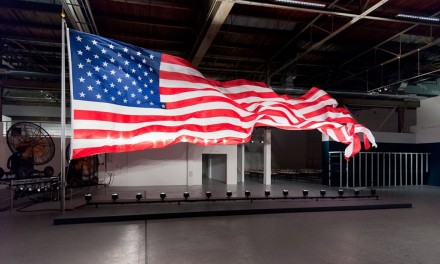
William Pope L., Trinket (Installation View), via MOCA
Inside the MOCA’s Geffen Contemporary building in Downtown Los Angeles, an immensely oversized American flag endlessly flutters in a synthetic breeze, held aloft by a series of industrial grade cooling fans. The breeze is intense, and the force exerted on the delicate stitching holding the iconic stars and stripes together is gradually tearing apart, a powerful metaphor in a time when the nation is riddled by high levels of police brutality, harsh military involvement overseas and increasingly vitriolic partisanship.
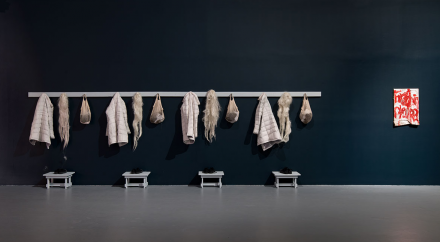
William Pope L., Trinket (Installation View), via MOCA
The work grounds its surrounding exhibition, Trinket, which combines a series of iconic and recently executed works by artist William Pope L., a pioneering talent in performance and installation art who has consistently redefined the medium while always challenging the fluid constructions of power, dominance and oppression that has long overshadowed the African-American experience.
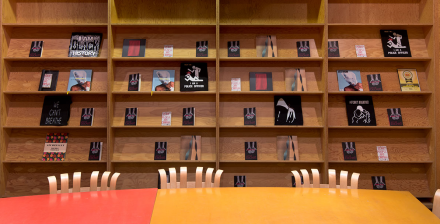
William Pope L., Trinket (Installation View), via MOCA
Pope L.’s work is never short on vitriol, even in its most subdued and unassuming pieces. In Polis, or The Garden, or Human Nature in Action, the artist presents a series of onions, a notably bitter and tear-inducing vegetable, painted in the stark red, white and blue of the American flag. Left out on the table to rot and decay, each onion is gradually sprouting long, snaking green roots, turning the dissipation of the vegetable itself into a striking, sarcastic challenge to the U.S.A.’s self-assured destiny, “that one nation, under God, shall not perish from this earth,” by questioning the form that this proliferation of statehood may in fact take.
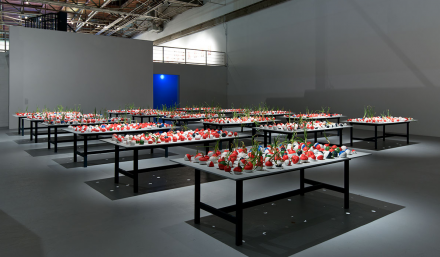
William Pope L., Trinket (Installation View), via MOCA
In other works from Pope’s career, the artist’s famous investigations of the body, and the emotional affect carried by its perversion, is heavily foregrounded. Several of the artist’s most famous “crawls,” works incorporating a human body horrifically dragging itself across objects, spatial frameworks or landscapes, call to mind the physical destruction of Chris Burden’s Through the Night Softly, but add in strong cultural or industrial signifiers. Snow Crawl, for instance, shows the artist crawling through the snowy landscapes of his home in Maine, dressed in a Superman costume. The isolation and subtle references to Superman’s icy “Fortress of Solitude” are potent, transposing the artist’s challenges to American ideology with his own juxtaposition of nature and physical degradation.
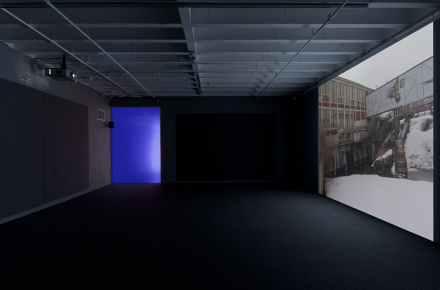
William Pope L., Trinket (Installation View), via MOCA
Similarly, Pope’s epic, nearly five hour-long performance video, Reenactor, challenges the racial undercurrents that run through the American phenomenon of Civil War reenactments, and its tie to the nation’s often bizarre fascination with simulacra. Depicting white males dressed as Robert E. Lee, going about banal everyday tasks, Pope L. effectively places this fetishistic engagement with the past within its proper historical context, one that looks nostalgically to the era of slavery, and which reproduces elements of it continually in the present day. The subtle acts of cultural violence this film gradually unearths gradually grow starker as each scene flows into the next.
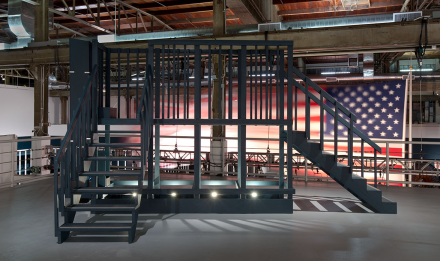
William Pope L., Trinket (Installation View), via MOCA
Pope L.’s work is often fierce, and rarely forgiving, but the human perspective in his work remains focused on the possibilities for change and subversion. Much like his onions, growing out from the degraded surface of patriotic fervor, the artist’s work seems committed to a new future, one in which the physical limitations of the body may in fact be transcended.
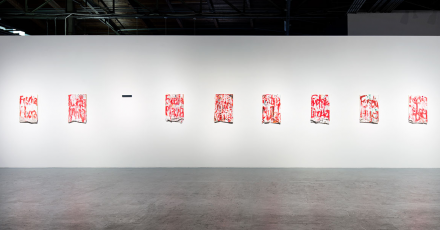
William Pope L., Trinket (Installation View), via MOCA
— D. Creahan
Read more:
William Pope L. at MOCA [Exhibition Site]
William Pope. L sets the U.S. flag waving at the MOCA/Geffen [LA Times]
William Pope. L [Artforum]



